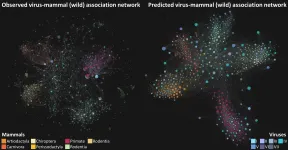(Press-News.org) Effective diagnostics, therapies and treatments for diseases and infections could increasingly involve re-engineering the body's internal biomechanisms at their most basic chemical and molecular foundations.
Growing knowledge about the body's biological processes is increasing the possibilities for restoring human health, says Xiao Wang, an associate professor of biomedical engineering in Arizona State University's Ira A. Fulton Schools of Engineering. He and a team of researchers are exploring ways to trigger and control cell differentiation and transition to unlock properties that may change bioengineers' approach to diagnostics, vaccine development and therapeutic treatments.
Recent research led by Wang and Alexander Green, an assistant professor of biomedical engineering at Boston University, reveals more about the potential for designing small add-on structures for biomolecules that can enhance their properties.
"There could be new and better kinds of applications for diagnostics, therapeutics and treatments, and for genome engineering," Wang says. "These could be big contributions to biomedicine."
The details about what the research may yield appear in the paper Predictable control of RNA lifetime using engineered degradation-tuning RNAs, published this week in the research journal Nature Chemical Biology.
Wang and Green's focus is on messenger RNA, or mRNA, which carries genetic information from DNA, the molecule that contains the genetic blueprint needed to develop and maintain organisms -- including humans.
Within cells, mRNA transmits messages from DNA to the protein-producing ribosomes, informing them of which proteins need to be synthesized at a given time. While DNA's status as the information repository of the cell means that it is very stable, mRNA's message-carrying role means it rapidly degrades. This degradation has made it harder to implement RNA-based therapies and diagnostics.
Wang, Green and their research team are devising methods of controlling degradation to produce predictable, precise and stable results. The new research paper describes how they are attempting to fine-tune the speed of mRNA degradation to boost the ability to perform biotechnological functions. To do this, they have identified specific RNA structural features to build a library of RNA components called degradation-tuning RNAs, or dtRNAs.
Attaching the dtRNAs to an RNA of interest through genetic engineering enables them to increase or decrease the RNA's degradation rate, and fine-tune gene expression levels in vivo and in vitro -- either inside a living organism or in a laboratory setting.
"We found that dtRNAs could be used with a variety of different types of RNAs and modify gene expression levels over a very wide range. These capabilities can increase the speed and sensitivity of medical diagnostics and give us better control over cell function," says Green, who was an assistant professor in ASU's Biodesign Institute and School of Molecular Sciences from 2015 to 2020 and is currently an adjunct professor with the school.
One of the more impactful results of these refining processes could be the development of mRNA-based vaccines that would be especially effective against viruses, Wang says.
"We can actually engineer the structure of RNA molecules in faster and more systematic ways that make them more efficient in how they behave," he says.
These behavior changes will inform how effective Wang and Green's bioengineering process will be at boosting the efficacy of diagnostics, vaccines, therapies and treatments.
INFORMATION:
Wang and Green's research team includes doctoral students Qi Zhang, Duo Ma, Kylie Standage-Beier and Xingwen Chen at ASU and doctoral student Kaiyue Wu at Boston University. Former ASU doctoral student Fuqing Wu, now at the Massachusetts Institute of Technology, contributed to earlier research that helped lead to the recent discoveries.
Funding for research described in the paper has come from the Arizona Department of Health Services, the Arizona Biomedical Research Centre, U.S. Department of Health & Human Services, the National Institutes of Health and the NIH Director's New Innovator Award, the National Science Foundation, the Bill and Melinda Gates Foundation and Arizona State University.
This release was authored by Joe Kullman, a science writer in the Ira A. Fulton Schools of Engineering at Arizona State University.
PITTSBURGH, June 25, 2021 - It is widely assumed that Americans' sexual activity took a nosedive during the early chaotic months of the coronavirus pandemic. But a new study from the University of Pittsburgh School of Medicine challenges this popular narrative.
In a research letter published in the Journal of Internal Medicine, scientists from Pitt and UPMC found that some people were having more sex during the pandemic than ever before. That group? Older men with erectile dysfunction.
"People's sexual lives contribute to the psychosocial fabric of society," said senior author Benjamin Davies, M.D., director of the Urologic Oncology Program at ...
Researchers at the National Institute of Standards and Technology (NIST) and Wavsens LLC have developed a method for using radio signals to create real-time images and videos of hidden and moving objects, which could help firefighters find escape routes or victims inside buildings filled with fire and smoke. The technique could also help track hypersonic objects such as missiles and space debris.
The new method, described in Nature Communications, could provide critical information to help reduce deaths and injuries. Locating and tracking first responders indoors is a prime goal for the public safety ...
A new University of Liverpool study could help scientists mitigate the future spread of zoonotic and livestock diseases caused by existing viruses.
Researchers have used a form or artificial intelligence (AI) called machine-learning to predict more than 20,000 unknown associations between known viruses and susceptible mammalian species. The findings, which are published in Nature Communications, could be used to help target disease surveillance programmes.
Thousands of viruses are known to affect mammals, with recent estimates indicating that less than 1% of mammalian viral diversity has been discovered to date. ...
Canadian researchers at The Ottawa Hospital, the University of Ottawa, the Bruyère Research Institute and ICES have built and validated an online calculator that empowers individuals 55 and over to better understand the health of their brain and how they can reduce their risk of being diagnosed with dementia in the next five years.
Their process was published today in the Journal of Epidemiology and Community Health, and the calculator is available at projectbiglife.ca.
Dementia is an umbrella term for loss of memory and other thinking abilities severe enough to interfere with daily life. Every year, 76,000 new cases of dementia are diagnosed ...
Multisystem Inflammatory Syndrome in Children (MIS-C) significantly affected more Black and Latino children than white children, with Black children at the highest risk, according to a new observational study of 124 pediatric patients treated at Children's National Hospital in Washington, D.C. Researchers also found cardiac complications, including systolic myocardial dysfunction and valvular regurgitation, were more common in MIS-C patients who were critically ill. Of the 124 patients, 63 were ultimately diagnosed with MIS-C and were compared with 61 patients deemed controls who presented with similar symptoms but ultimately had an alternative diagnosis.
In the study, published ...
Burnout is a widespread reality in today's NHS
Current NHS workforce plans are "a smart looking car minus the engine"
An editorial published by The BMJ today raises important concerns about the health
and wellbeing of the NHS workforce after a parliamentary report found "burnout is a widespread reality in today's NHS."
Commenting on the report, Suzie Bailey of the King's Fund says: "Excessive workloads need to be dealt with at every level of the health and care system."
She suggests that ineffective workforce planning is partly to blame, citing evidence ...
New research has discovered that common artificial sweeteners can cause previously healthy gut bacteria to become diseased and invade the gut wall, potentially leading to serious health issues.
The study, published in the International Journal of Molecular Sciences, is the first to show the pathogenic effects of some of the most widely used artificial sweeteners - saccharin, sucralose, and aspartame - on two types of gut bacteria, E. coli (Escherichia coli) and E. faecalis (Enterococcus faecalis).
Previous studies have shown that artificial sweeteners can change the number and type of bacteria in the gut, but this new molecular research, led by academics from Anglia Ruskin University (ARU), has demonstrated that sweeteners can also make ...
A growing trove of data to help scientists understand the biology of Alzheimer's disease among diverse populations within the context of sociocultural, behavioral and environmental factors is now available through the Institute for Translational Research at The University of North Texas Health Science Center at Fort Worth (HSC).
The research data is the result of the Health and Aging Brain among Latino Elders (HABLE) study launched in 2017 with $12 million in funding from the National Institutes of Health and headed by Sid O'Bryant, PhD, Executive Director of the Institute.
In 2020, the HABLE study received an additional $45 million from ...
Over the last decade, severe outbreaks of bacterial canker have caused huge economic losses for kiwi growers, especially in Italy, New Zealand, and China, which are among the largest producers. Bacterial canker is caused by the bacterial pathogen Pseudomonas syringae pv. actinidiae (Psa) and more recent outbreaks have been particularly devastating due to the emergence of a new, extremely aggressive biovar called Psa3.
Due to its recent introduction, the molecular basis of Psa3's virulence is unknown, making it difficult to develop mitigation strategies. In light of this dilemma, a group of scientists at the University of Verona and University of Rome collaborated on ...
In children with rhabdomyosarcoma, or RMS, a rare cancer that affects the muscles and other soft tissues, the presence of mutations in several genes, including TP53, MYOD1, and CDKN2A, appear to be associated with a more aggressive form of the disease and a poorer chance of survival. This finding is from the largest-ever international study on RMS, led by scientists at the National Cancer Institute's (NCI) Center for Cancer Research, part of the National Institutes of Health.
The study, published in the Journal of Clinical Oncology on June 24, provides an unprecedented look at data for a large cohort of patients with RMS, offering genetic clues that could lead to more widespread use of tumor genetic ...






